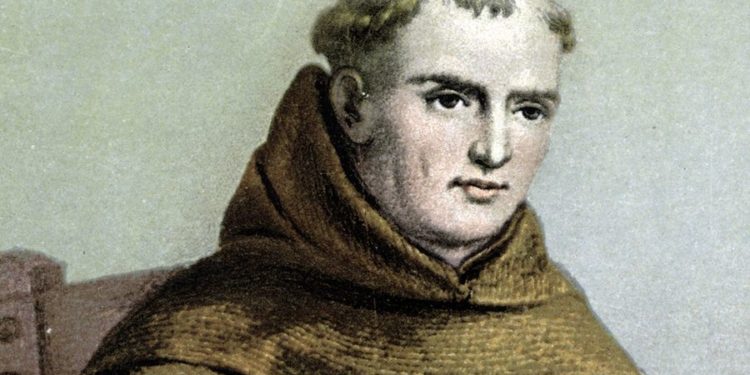“If a Planned Parenthood fundraiser can be held at LMU in Roski, certainly a statue of this country’s first Hispanic saint canonized by the first Hispanic pope can be in a place of honor and respect at LMU,” he said. “If you wish to have the statue placed inside, so as to lessen the likelihood of vandalism, it should be in a place of high visibility as it was before. We suggest putting it in Roski.”
Renew LMU has asked supporters of the Serra statue to add their name to Chavira’s letter at its website, RenewLMU.com. The alumni group describes itself as “an alliance of students, alumni, faculty, donors, and other LMU supporters who seek to strengthen LMU’s Catholic mission and identity.” CNA sought comment from RenewLMU but did not receive a response by deadline.
Serra, a Franciscan friar from Spain, left a prestigious university chair in Majorca for what is now the United States in 1749. He founded a system of missions to evangelize the Indigenous in modern-day California. He celebrated more than 6,000 baptisms and 5,000 confirmations, and the missions are at the historic center of many of the state’s cities.
While he was lionized through much of the 20th century, critics have since lambasted Serra as a symbol of European colonialism. They said the missions engaged in the forced labor of Native Americans, sometimes claiming Serra himself was abusive.
Serra’s defenders point to the priest’s advocacy for native people and a champion of human rights. They note that he often found himself at odds with Spanish authorities over mistreatment of native people, and the native communities themselves showed an outpouring of grief at his death. They said Serra is wrongly blamed for injustices that came after his death.
Last year, the death of Minnesota man George Floyd during his arrest by a police officer, who was later convicted of his murder, led to racial tensions, protests against police brutality, and riots. In California, protesters and vandals targeted statues of Serra on the grounds that he represented colonialism and oppression of Native Americans. Some state and local lawmakers renewed previous efforts to remove images of Serra from public parks and other official places, and many succeeded.
The Los Angeles-area San Gabriel Mission, which Serra founded in 1771, burned in a devastating fire on July 11, 2020. The alleged arsonist, 57-year-old John David Corey, faces two felony counts in connection with the fire. He was known to the mission and had quarreled with staff members in the past. He reportedly harbored anger toward the Catholic Church.
On Nov. 4, Loyola Marymount University hosted a discussion about Serra linked to the observance of Indigenous Heritage Month, the university news site LMU This Week reported.
At the discussion Robert M. Senkewicz, emeritus history professor at Santa Clara University, cited both a letter from Serra seeking mercy for indigenous people who had attacked a mission and another letter instructing harsh punishment for indigenous people who had left a mission and were returned by force. He depicted the Catholic mission presence and the Spanish military presence as mutually reinforcing and said Catholic evangelization efforts accepted the use of force. Mexican and Californian representations of this time of history erased the indigenous peoples’ experiences, Senkewicz said.
Cecilia González-Andrieu, a Loyola Marymount professor of theological studies, said that the missions are now in mainly Latino neighborhoods, but she said there is no devotion to Serra at these places. Edgar Perez, a member of the Gabrielino-Tongva people, said the mission system planted the seeds for policies to separate indigenous people from their language and religion and lands. Serra is an integral part of that history, he said.
Than Povi Martinez, a sophomore dance major at Loyola Marymount from the Tewa Pueblo People of San Ildefonso in New Mexico, said Serra’s statue should be permanently removed. According to LMU This Week, she said the statue represents pain and racism and such representations trigger trauma.
(Story continues below)
Among the critics of Serra are the Indigenous Student Union of LMU. A petition on Change.org attributed to the group had 243 signatures as of Wednesday afternoon. The petition said Serra’s statue should “stay off of our LMU campus.”
“One of our founding goals at ISU has been the removal of the Junipero Serra statue on LMU’s campus,” the petition said. “We see this as just one step acknowledging that LMU currently resides on stolen land of the Tongva Tribe and taking action towards making our campus a safe and welcoming place for Indigenous people and others of marginalized identities and backgrounds.”
“We demand that the statue stay off campus and that the education surrounding Christian colonization be conducted through a different, more intentional manner that centers the lives of our community members of Indigenous and/or marginalized backgrounds,” the group continued. “If the university is truly committed to ongoing efforts to increase diversity and inclusion within our institution, the Junipero Serra statue would be kept off our campus.”
Dr. Reuben Mendoza, an archeologist and professor at California State University-Monterey Bay, who has studied the missions for more than 25 years, told CNA last year that Serra was motivated by a missionary zeal to bring salvation to the Native people through the Catholic faith, rather than by genocidal, racist, or opportunistic motivations.
“Serra writes excitedly about how he had finally found his life’s calling, and that he would give his life to these people and their salvation,” Mendoza said.
Fr. Tom Elewaut, pastor of the Old Mission Basilica of San Buenaventura in Ventura, told CNA last year that indigenous people are not uniformly critical of Serra.
Credit: Source link




